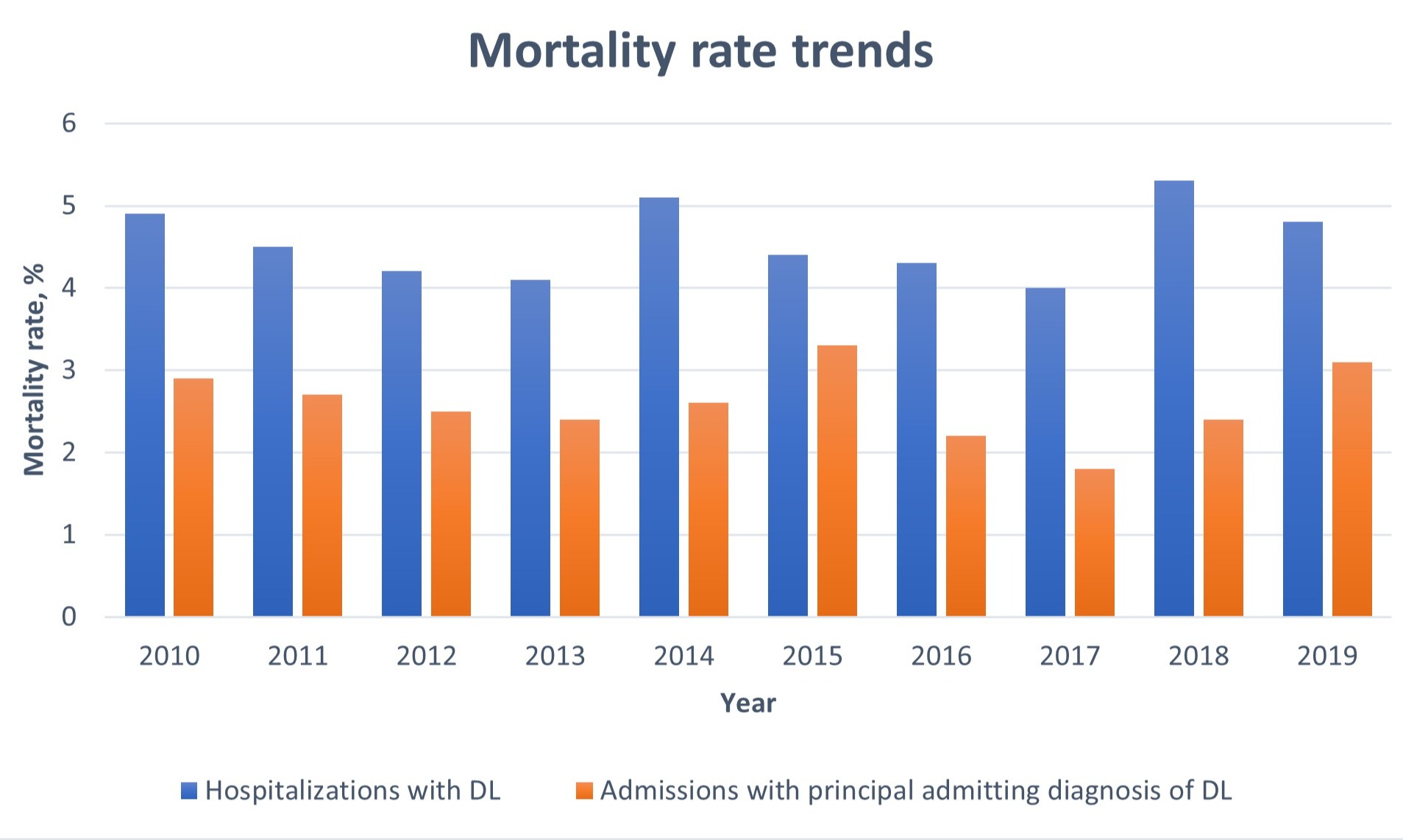Back
Poster Session C - Monday Afternoon
C0319 - Trends and Disparities in Outcomes of Hospitalizations With Dieulafoy Lesions: A Decade-Long Analysis of the Nationwide Inpatient Sample
Monday, October 24, 2022
3:00 PM – 5:00 PM ET
Location: Crown Ballroom

Pius E. Ojemolon, MD
John H. Stroger, Jr. Hospital of Cook County
Chicago, IL
Presenting Author(s)
Pius E. Ojemolon, MD1, Rachael Okobia, MD2, Robert Kwei-Nsoro, MD1, Hisham Laswi, MD1, Hafeez Shaka, MBBS1
1John H. Stroger, Jr. Hospital of Cook County, Chicago, IL; 2University of Benin, Chicago, IL
Introduction: Dieulafoy lesion (DL) is a rare yet potentially life-threatening cause of acute gastrointestinal bleeding. There is a paucity of research on the impact of sociodemographic indices on DL hospitalization outcomes. This study aimed to describe the epidemiologic trends and effects of sociodemographic disparities on outcomes among DL hospitalizations over a decade.
Methods: We queried Nationwide Inpatient Sample (NIS) databases from 2010 to 2019, identified hospitalizations with DL, and excluded those of patients less than 18 years. We obtained the incidence and admission rate of DL per 1,000,000 adult hospitalizations for each year. We analyzed trends in mortality rate, mean length of hospital stay (LOS), and mean total hospital charge (THC). We highlighted disparities in outcomes stratified by sex, race, and mean household income (MHOI) quartile. We used multivariable regression analysis to obtain trends in incidence and admission rates, mortality, LOS, and THC adjusted for age categories, sex, and race. We used Joinpoint regression analysis to obtain trends in adjusted rates. Threshold for statistical significance was set at 0.05.
Results: Of the 305 million hospitalizations included in our study, 59,862 were complicated by DL, with 40,356 principal admissions for DL. On Joinpoint analysis, there was no trend in adjusted incidence rate (p = 0.1) or adjusted admission rate (p = 0.05) over the study period. There was also no trend in adjusted mortality rate among all hospitalizations with DL (p trend = 0.855), admissions with principal diagnosis of DL (p trend = 0.754) or adjusted LOS (p trend = 0.879) but there was a US$4,011 increase in adjusted THC (p trend < 0.001).
Middle-aged adults had increased odds of mortality (adjusted odds ratio, aOR = 1.48) compared to young adults (p = 0.046). Females had 16% lower odds of adjusted mortality (p trend = 0.046), 0.67 days reduction in adjusted LOS (p trend = 0.001), and US$16,905 reduction in adjusted THC (p trend < 0.001) compared to males. Blacks had 2.6 days increase in adjusted LOS and US$33,685 increase in adjusted THC (both p trends < 0.001) compared to Whites. Hispanics had increased odds of mortality (aOR = 1.76), 1.5 days increase in adjusted LOS, and US$50,476 increase in adjusted THC compared to Whites ((p trends = 0.018, 0.003 and < 0.001 respectively).
Discussion: Outcomes of DL hospitalizations were worse in middle-aged adults, males, and ethnic minorities. Further studies may be needed to elucidate the reasons behind these findings.

Disclosures:
Pius E. Ojemolon, MD1, Rachael Okobia, MD2, Robert Kwei-Nsoro, MD1, Hisham Laswi, MD1, Hafeez Shaka, MBBS1. C0319 - Trends and Disparities in Outcomes of Hospitalizations With Dieulafoy Lesions: A Decade-Long Analysis of the Nationwide Inpatient Sample, ACG 2022 Annual Scientific Meeting Abstracts. Charlotte, NC: American College of Gastroenterology.
1John H. Stroger, Jr. Hospital of Cook County, Chicago, IL; 2University of Benin, Chicago, IL
Introduction: Dieulafoy lesion (DL) is a rare yet potentially life-threatening cause of acute gastrointestinal bleeding. There is a paucity of research on the impact of sociodemographic indices on DL hospitalization outcomes. This study aimed to describe the epidemiologic trends and effects of sociodemographic disparities on outcomes among DL hospitalizations over a decade.
Methods: We queried Nationwide Inpatient Sample (NIS) databases from 2010 to 2019, identified hospitalizations with DL, and excluded those of patients less than 18 years. We obtained the incidence and admission rate of DL per 1,000,000 adult hospitalizations for each year. We analyzed trends in mortality rate, mean length of hospital stay (LOS), and mean total hospital charge (THC). We highlighted disparities in outcomes stratified by sex, race, and mean household income (MHOI) quartile. We used multivariable regression analysis to obtain trends in incidence and admission rates, mortality, LOS, and THC adjusted for age categories, sex, and race. We used Joinpoint regression analysis to obtain trends in adjusted rates. Threshold for statistical significance was set at 0.05.
Results: Of the 305 million hospitalizations included in our study, 59,862 were complicated by DL, with 40,356 principal admissions for DL. On Joinpoint analysis, there was no trend in adjusted incidence rate (p = 0.1) or adjusted admission rate (p = 0.05) over the study period. There was also no trend in adjusted mortality rate among all hospitalizations with DL (p trend = 0.855), admissions with principal diagnosis of DL (p trend = 0.754) or adjusted LOS (p trend = 0.879) but there was a US$4,011 increase in adjusted THC (p trend < 0.001).
Middle-aged adults had increased odds of mortality (adjusted odds ratio, aOR = 1.48) compared to young adults (p = 0.046). Females had 16% lower odds of adjusted mortality (p trend = 0.046), 0.67 days reduction in adjusted LOS (p trend = 0.001), and US$16,905 reduction in adjusted THC (p trend < 0.001) compared to males. Blacks had 2.6 days increase in adjusted LOS and US$33,685 increase in adjusted THC (both p trends < 0.001) compared to Whites. Hispanics had increased odds of mortality (aOR = 1.76), 1.5 days increase in adjusted LOS, and US$50,476 increase in adjusted THC compared to Whites ((p trends = 0.018, 0.003 and < 0.001 respectively).
Discussion: Outcomes of DL hospitalizations were worse in middle-aged adults, males, and ethnic minorities. Further studies may be needed to elucidate the reasons behind these findings.

Figure: Figure 1: Trends in mortality rates among hospitalizations with DL and admissions with principal admitting diagnosis of DL
Disclosures:
Pius Ojemolon indicated no relevant financial relationships.
Rachael Okobia indicated no relevant financial relationships.
Robert Kwei-Nsoro indicated no relevant financial relationships.
Hisham Laswi indicated no relevant financial relationships.
Hafeez Shaka indicated no relevant financial relationships.
Pius E. Ojemolon, MD1, Rachael Okobia, MD2, Robert Kwei-Nsoro, MD1, Hisham Laswi, MD1, Hafeez Shaka, MBBS1. C0319 - Trends and Disparities in Outcomes of Hospitalizations With Dieulafoy Lesions: A Decade-Long Analysis of the Nationwide Inpatient Sample, ACG 2022 Annual Scientific Meeting Abstracts. Charlotte, NC: American College of Gastroenterology.
